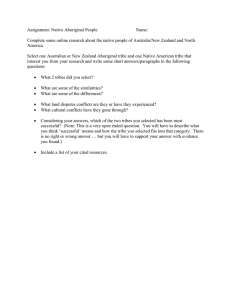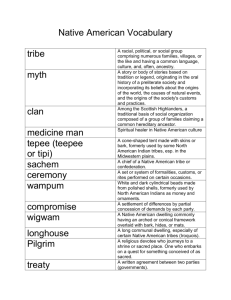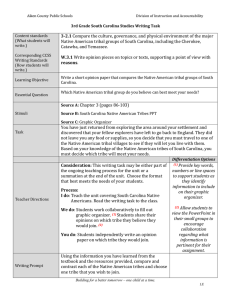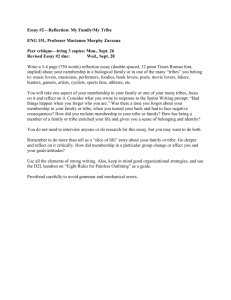Learning to View Your Customers as a Powerful Tribe
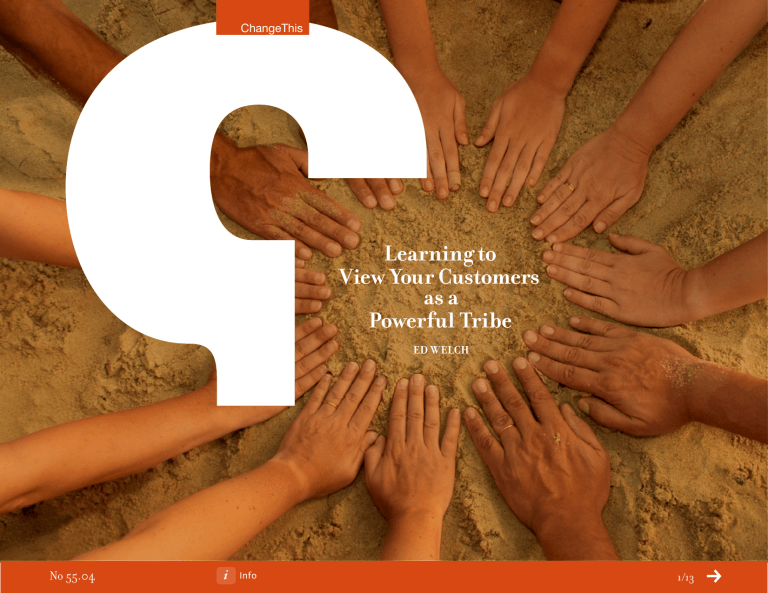
ChangeThis
Learning to
View Your Customers as a
Powerful Tribe
Ed WELCh
No 55.04
1/13
No 55.04
ChangeThis
A CEO using Twitter to connect with customers? Why?
Tony Hsieh (pronounced “Shay”), CEO of Zappos.com, uses Twitter to connect with customers.
Why would a busy, important, successful CEO want to connect with customers? Make no mistake;
Hsieh isn’t using Twitter for a marketing gimmick, but to make meaningful connections.
A maverick bought the Mavericks?
The Dallas Mavericks went from being one of the worst basketball franchises in the National
Basketball Association (NBA), to being one of the best and most valuable. The reason is usually sitting somewhere in the crowds at Maverick games. His name is Mark Cuban.
Mark is the owner of the Dallas Mavericks. His leadership lifted them to heights never before thought possible. How? Mark knows how to connect. Guess where he sits during games? With the fans.
Guess who reads all the emails sent to the Dallas Mavericks? Mark does. He usually wears a jersey, not a suit and tie. He dresses like a fan and acts like a fan. Mark understands that connecting with fans is the key to the success of the Mavericks.
Herb Kelleher, a legend of Southwest Airlines.
Herb Kelleher was frequently spotted on Southwest flights, chatting with ordinary passengers. Why?
Surely he had more important things to do? Kelleher was connecting with his customers.
2/13
ChangeThis
No 55.04
What’s the big secret? “It’s the economy connections, stupid.”
To truly appreciate the significance and power of connections, one must understand them in the context of modern tribal behavior - particularly in the context of the Net. So, what is a tribe?
“A tribe is a group of people connected to one another, connected to a leader, and connected to an idea.”
SETH GODIN
Known for his brevity, Seth uses the word “connected” three times in this definition. Think that’s a coincidence? Remember, the connections we’re talking about aren’t the kind you use when you need a new job or a promotion. In this context, connections are the glue enabling people to identify with an idea, each other and a leader.
Connections are the glue enabling people to identify with an idea, each other and a leader.
As a business it’s tempting to think of a “tribe” as a “customer base.” That’s wrong. People aren’t part of a tribe simply because they buy a product or service. What qualifies them as a tribe are their connections. Tribes of customers are connected to an idea, each other, products, services, employees, etc.—creating a network of connections to the business as a whole.
Let’s use the Toyota Prius as an example. When someone purchases a Prius, they’re not just buying a car, they’re becoming part of the Prius Tribe and all it stands for. Perhaps you’ve noticed the manner in which
Prius owners seem to identify themselves as something “special”? That’s tribal recognition.
Now, think of another business (any business). Are its customers a tribe or simply names in a database?
3/13
ChangeThis
People need to feel connected as much as businesses need customers. This is nothing new, but it leads us to the great “tribal catalyst”—the Net. Without the social tools of the Net, powerful, online tribes would never have formed.
The Net has provided tools for an exponential explosion of long-desired tribal connectivity.
Social networking tools such as email, forums and blogs began the facilitation of tribal connectivity.
Later, social networking sites like Twitter, FaceBook,
To implement the concept of tribes, everyone from the
CEO
to the janitor should be working to build meaningful connections with customers.
MySpace, LinkedIn and many others rose up to accommodate increased demand for more elaborate tribal connectivity. Long suppressed tribal desires have blossomed as people now belong to more tribes than ever before, most of them on the Net.
Caution: don’t read any of this and assume tribal connections are a quick fix for a broken business.
To implement the concept of tribes, everyone from the CEO to the janitor should be working to build meaningful connections with customers.
No 55.04
4/13
ChangeThis
I found value in a buggy tribe.
A while back, I decided my family needed a small dune buggy. After an exhausting search of conflicting marketing messages (imagine that), I came across an online forum created by dune buggy enthusiasts. These people are connected. They’re connected to each other, the forum leaders, and the idea of having fun in a dune buggy.
This buggy tribe was quite helpful. Its members showed me which buggies to avoid, the best buggy prices, and which buggies were the best for my budget. Often, they would direct me away from poor buggies they had purchased, as they didn’t want me to make the same mistake they had made.
Let’s be crystal clear, my $2000 purchase decision was almost entirely influenced by this buggy tribe. Why isn’t your business leading a tribe like this, or at least actively participating in the tribe?
Not to market, but to make connections.
Not unlike this buggy tribe, you’ll find tribes of people passionate about products ranging from condoms to cars and various products and businesses in between. Don’t underestimate their power.
No 55.04
5/13
ChangeThis
The traditional customer service mentality needs to be replaced by a tribal mentality.
The entire business should be the ‘customer service department.’
Many businesses fall into the trap of traditional customer service thinking. NO! It’s not the responsibility of the customer service department to make sure customers are satisfied. Wow, that’s worth repeating!
Obviously, a customer service department is needed, but the traditional customer service mentality needs to be replaced by a tribal mentality.
Employees from all levels of the business should actively be making connections with customers. Not just when a customer is having trouble, but through every phase of business.
Here’s a great idea: Each day, allow one randomly selected customer service phone call or email to make its way to the CEO. Let the CEO connect with the customer. Imagine that, a CEO listening to a customer’s problems and helping to solve it! Where I come from we call it ”tribe building.”
We also call it “common sense.”
No 55.04
6/13
No 55.04
ChangeThis
The entire business should be the ‘marketing department.’
Building and strengthening meaningful connections = a healthy tribe of customers = effective, efficient word-of-mouth marketing and so much more.
Too often, we see businesses turn to marketing executives as they look for sales growth. News flash!
Marketing no longer works the same as in years past. Let go of the past and embrace today.
“Everyone is a marketer.”
SETH GODIN
If everyone is a marketer, what do employees market? What’s the customer service department marketing? Incompetence? Lack of caring? No power? Just a kind voice? Fairness?
What are janitors marketing? Sloppiness? Carelessness? Kindness? Pride in their work? Grouchiness?
What’s the CEO marketing? Waste? Extravagance? Arrogance? Out of touch? In touch?
Caring only for the bottom line? Ivory tower syndrome?
What are customers marketing? Fulfillment? Belonging? Joy? Anger? Frustration? Your product?
Your service? Your business?
What are you marketing? Fear? Courage? Competence? Self-interests? Insecurity? Pride?
Butt-kissing syndrome?
Business leaders, let go of your fear, grasp the changing realities of today and fly with Eagles.
7/13
ChangeThis
Ignoring the power of connections and tribes.
Want to hear a secret? You promise not to tell anyone? Alright, Toyota manufactures higher quality automobiles than GM, and sells them for about the same price. What? You already knew that?
Darn that Internet! No secrets are safe anymore.
Each day, customers are gaining more of the control (via tribal connections) that businesses are losing.
General Motors (GM) is now on government life support. It’s been sad to observe the slow death of this corporate dinosaur, unwilling to adapt to the new ways of the world. Arrogant to the end, GM has been unwilling to truly connect with its customers, choosing instead to mass-market automobiles that are unable to compete against its competition. GM has been good at talking AT us, but not WITH us.
Ironically, all that remains for most business leaders is the illusion of control. Each day, customers are gaining more of the control
(via tribal connections) that businesses are losing. Many executives are refusing to acknowledge these shifts in control.
Dell learned about tribes the hard way. Perhaps you’ve heard the story of Jeff Jarvis—maybe more than once? Dell learned about tribes as they watched their customers form a tribe around the leadership of Jarvis. What started as a frustrated blog post turned into a large movement powerful enough to influence Dell.
No 55.04
8/13
ChangeThis
Abusing social media.
I have way too much fun watching businesses fall all over themselves, looking for a way to “take advantage” of the connecting power of the Net to market themselves using social media.
Let’s be very clear. The moment a person or business attempts to use social media connections for the purpose of interruption marketing, they lose. They may not lose in the short-term, but they’ll certainly lose in the long-term. Ever have a friend who regularly tried to sell you stuff
(network marketing, etc.)? Puts you in an awkward position, doesn’t it? Don’t like it, do you?
Changes the relationship a little if they persist, doesn’t it?
Please don’t make the mistake of using social media connections for interruption marketing.
You can’t build and strengthen connections and frustrate people at the same time. It doesn’t work.
Interruption marketing is a “connection destroyer.”
Another great way to abuse social media is using it for self-promotion. News flash, people don’t care about you, they care about them. Nobody wants to hear about your stuff, UNLESS it comes from someone other than you. It’s not complicated. No tricks here, please! Don’t be the embarrassed company caught paying people to talk nice about them.
Be careful with your connections. Love your connections. Be gentle with them. Just like any other business asset, true connections take time and money to nurture and build. Don’t destroy them with shortsighted, half-baked ideas (unsolicited email, etc.).
No 55.04
9/13
No 55.04
ChangeThis
You still don’t get it?
Just to clarify, we’re not talking about some silly promotion where a customer wins a contest with his/her idea accepted for a commercial. No, we’re talking about everyone, from the CEO to the janitor, building real, lasting, deep connections with customers—a powerful tribe.
We’ve seen the Net facilitate an explosion of connections—people connecting with like-minded people, ideas, products, services, etc. Anywhere people connect, leaders emerge and tribes form. Astonishingly, where are businesses? Why aren’t businesses attempting to lead a tribe like the aforementioned buggy tribe, or the “Dazzle Condom Tribe,” or some other tribe (you can’t count them all).
For years, a customer’s story didn’t really matter. After all, who could we tell our stories to ?
We certainly couldn’t connect with each other on the scale the Net allows. Today, the customer’s story and the business’s story must be similar—otherwise it won’t be credible.
Today, the customer’s story and the business’s story must be similar—otherwise it won’t be credible.
Wait a minute. Do businesses actually believe we listen to their marketing more than we listen to our friends (online and off), who have actually used the products or services we might be interested in? Astonishingly, I believe they still do! Go figure!
Business leaders, it’s time to wake up and stop embarrassing yourselves.
10/13
ChangeThis
Imagine a tribal business.
Imagine a business that works to connect with customers and potential customers. Most businesses say they want to know customers better—but do they really? They don’t act like it. They send out goofy, informal surveys and hold focus groups, but how often have you been contacted by a business truly desiring to make a connection with you for a mutual benefit? Me neither!
When customers feel connected and valued, they’ll evangelize a business. These people will market products and services for free!
Believe it or not, we customers are smarter than most businesses think we are. Are you an executive?
Get out of the office, lose the goofy clothing and connect with your customers. Why waste money on consultants? Customers are an untapped gold mine!
Information is power. Customers have it, but they won’t share it unless a true connection exists.
No 55.04
11/13
ChangeThis
Today? Tomorrow? When?
It’s time for connections, time for tribes, time for Business 10.1. What are you waiting for?
People are connecting like never before. Business connecting with customers is the ultimate recipe for customer satisfaction and business prosperity. Isn’t that the essence of good business?
Why did we allow the tail of Wall Street to wag the business? It’s time to put things back in order, connect with customers first, and then great profits will follow.
Do you have the courage to embrace these realities? Do you have the courage to turn your back on established corporate culture and connect a business to a hungry tribe of customers? I’ve written nothing new. These are ancient secrets, long forgotten. Deep down, you know this stuff is true.
Your business needs you and, more importantly, your customers need you. Learn more about connections in the context of tribes. Develop a strategy to implement them into your organization.
At the time of this writing, we’re entering a recession and highly uncertain economic times.
What’s there to lose? Businesses are laying off employees every day, they need a competitive advantage. Do you have the courage to lead a tribe?
No 55.04
12/13
No 55.04
ChangeThis info
AbOuT THE AuTHOr
Ed Welch is an entrepreneur, author of 101 Ways to Destroy Your Tribe , contributor to the Tribes Q&A book , contributor to the Tribes Casebook and founder of Welch, Inc. One of Ed’s passions is to help businesses adapt to the evolving tribal nature of people using the Net. He’s a member of Triiibes.com
and also writes for the
Tribe Building Blog . He received his formal education from Oklahoma State University in Business Finance and he’s an enthusiastic student of Seth Godin’s business principles.
SEnd THIS
Pass along a copy of this manifesto to others.
SubSCrIbE
Sign up for our free e-newsletter to learn about our latest manifestos as soon as they are available. bOrn On dATE
This document was created on February 11, 2009 and is based on the best information available at that time.
Check here for updates .
AbOuT CHAnGETHIS
ChangeThis is a vehicle, not a publisher.
We make it easy for big ideas to spread.
While the authors we work with are responsible for their own work, they don’t necessarily agree with everything available in ChangeThis format. But you knew that already.
ChangeThis is supported by the love and tender care of 800-CEO-READ. Visit us at 800-CEO-READ or at our daily blog.
COpYrIGHT InfO
The copyright of this work belongs to the author, who is solely responsible for the content.
This work is licensed under the Creative
Commons Attribution-NonCommercial-
NoDerivs License. To view a copy of this license, visit Creative Commons or send a letter to Creative Commons, 559 Nathan
Abbott Way, Stanford, California 94305, USA.
Cover image from iStockphoto®
WHAT YOu CAn dO
You are given the unlimited right to print this manifesto and to distribute it electronically (via email, your website, or any other means). You can print out pages and put them in your favorite coffee shop’s windows or your doctor’s waiting room. You can transcribe the author’s words onto the sidewalk, or you can hand out copies to everyone you meet. You may not alter this manifesto in any way, though, and you may not charge for it.
13/13
